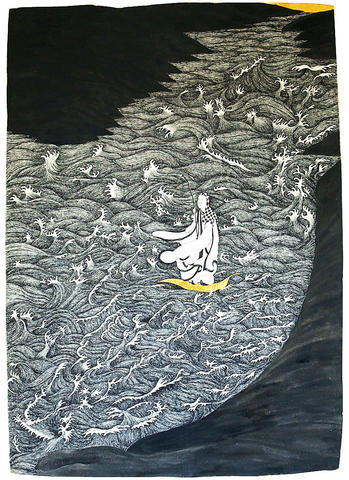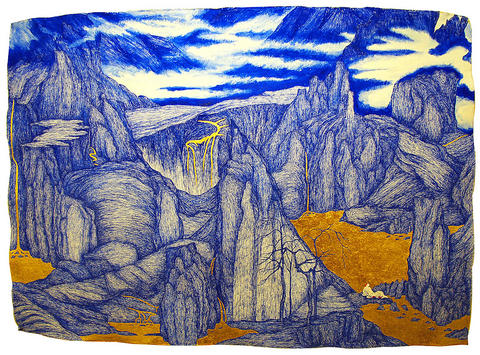The Glenfiddich Distillery, famed for its single malt scotch, is also home to one of the more innovative international artist residency programs, which began in 2002. It all started when the company wanted to establish a corporate art collection at the distillery.
The artist residency, which is located in the several empty houses on the distillery premises, provides funding, accommodation and studio space for eight artists every summer and stipulates that residents have to create an artwork for the collection. Artists are asked to draw inspiration from Glenfiddich's brew and the local environment.
Taiwanese artist Yao Jui-chung (姚瑞中) spent his three-month residency creating mainly ink drawings combined with gold leaf on handmade paper. The framed results are on display at the IT Park until Dec. 8

PHOTOS:COURTESY OF YAO JUI-CHUNG
The exhibition opening last week at the IT Park was attended by the residency's director, clad in a kilt and sporting dreadlocks.
The residency - located in Dufftown, Scotland, with a population of 2,000 - was a contrast to the hectic pace of Taipei life, which Yao is used to. The artist, who is well-known in the capital's art circle, helps run the nearby VT Art Salon, has published several books, makes videos, photos and drawings and teaches at a university. The Scottish town's slow pace and the country's pre-Christian roots sparked Yao's frenetic burst of creativity.
The drawings include depictions of Yao's hobbies - bathing in hot springs, mountain climbing, appreciating nature, playing chess - while referring to classical Chinese painting from the late Ming Dynasty.

PHOTOS:COURTESY OF YAO JUI-CHUNG
Yao's previous work took a critical view of Taiwan's turbulent political and social situation. In his new works, he has continued painting his dog-faced characters, which represent cynics and devils. Yet, these drawings seem to be the weakest of the series, perhaps because they illustrate the contentious dichotomy of local politics and lose any poetic feeling.
Yao's strongest drawings are those that reference Scottish mythology, ancient Pictish stone circles, the dramatic Scottish highlands and Chinese landscape painting.
Wonderful: The Holy Ridge under the Milk-way, a figuratively-shaped mountain that is formed by intensely worked black ink scribbles, shows the artist's erratic, quick-handed movements. Gold leaf rivulets stream forth from mysterious inner mountain sources. This huge mountain range dwarfs a red-cloaked figure who appears to be at one with nature, enjoying the heavenliness of the scene.

PHOTOS:COURTESY OF YAO JUI-CHUNG
Graphically, Wonderful: Crossing the Taiwan Strait by a Leaf is a perfect work of art. White crested waves grasping the air like greedy hands are finely delineated in black lines and carry a delicate Buddha-like figure on a small gold leaf.
The mystical Wonderful: Looking the Waterfall in Tain-Da-Na is a good example of Yao's merging of Scottish and Chinese landscapes. It feels like a real place, but also a dreamlike, imaginary landscape.
Yao, who abandoned the classical for the avant-garde, was pleasantly surprised to rediscover the richness of traditional art. It was his studied knowledge of the past that helped him create something new. And that is probably one of the best reasons to have an artist residency program. I'll drink to that.

Taiwan can often feel woefully behind on global trends, from fashion to food, and influences can sometimes feel like the last on the metaphorical bandwagon. In the West, suddenly every burger is being smashed and honey has become “hot” and we’re all drinking orange wine. But it took a good while for a smash burger in Taipei to come across my radar. For the uninitiated, a smash burger is, well, a normal burger patty but smashed flat. Originally, I didn’t understand. Surely the best part of a burger is the thick patty with all the juiciness of the beef, the

This year’s Miss Universe in Thailand has been marred by ugly drama, with allegations of an insult to a beauty queen’s intellect, a walkout by pageant contestants and a tearful tantrum by the host. More than 120 women from across the world have gathered in Thailand, vying to be crowned Miss Universe in a contest considered one of the “big four” of global beauty pageants. But the runup has been dominated by the off-stage antics of the coiffed contestants and their Thai hosts, escalating into a feminist firestorm drawing the attention of Mexico’s president. On Tuesday, Mexican delegate Fatima Bosch staged a

The ultimate goal of the Chinese Communist Party (CCP) is the total and overwhelming domination of everything within the sphere of what it considers China and deems as theirs. All decision-making by the CCP must be understood through that lens. Any decision made is to entrench — or ideally expand that power. They are fiercely hostile to anything that weakens or compromises their control of “China.” By design, they will stop at nothing to ensure that there is no distinction between the CCP and the Chinese nation, people, culture, civilization, religion, economy, property, military or government — they are all subsidiary

Would you eat lab-grown chocolate? I requested a sample from California Cultured, a Sacramento-based company. Its chocolate, not yet commercially available, is made with techniques that have previously been used to synthesize other bioactive products like certain plant-derived pharmaceuticals for commercial sale. A few days later, it arrives. The morsel, barely bigger than a coffee bean, is supposed to be the flavor equivalent of a 70 percent to 80 percent dark chocolate. I tear open its sealed packet and a chocolatey aroma escapes — so far, so good. I pop it in my mouth. Slightly waxy and distinctly bitter, it boasts those bright,